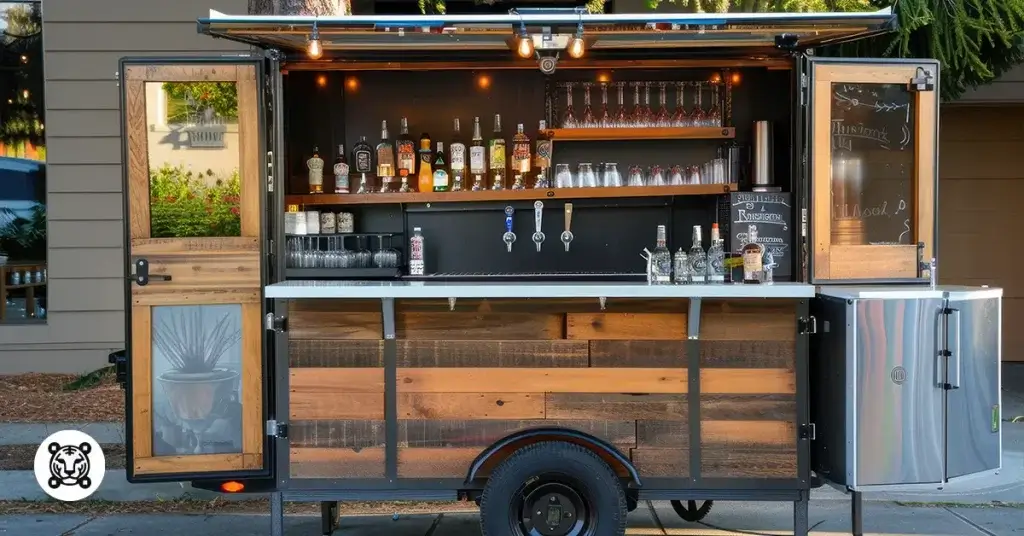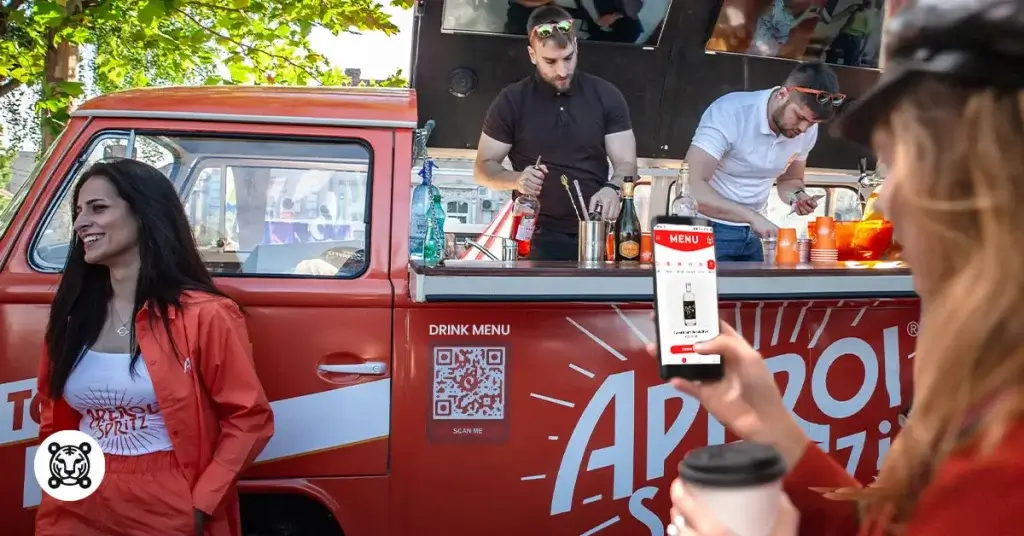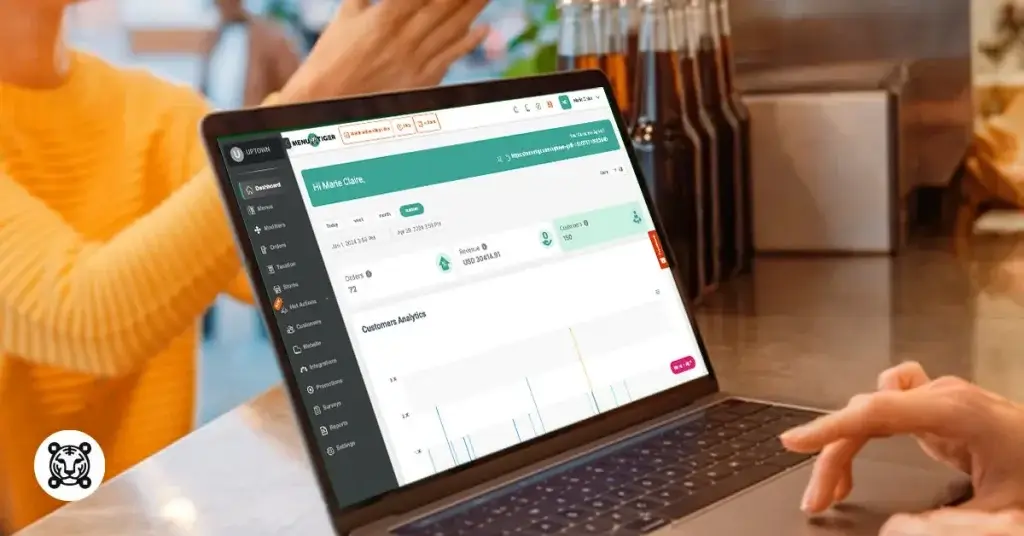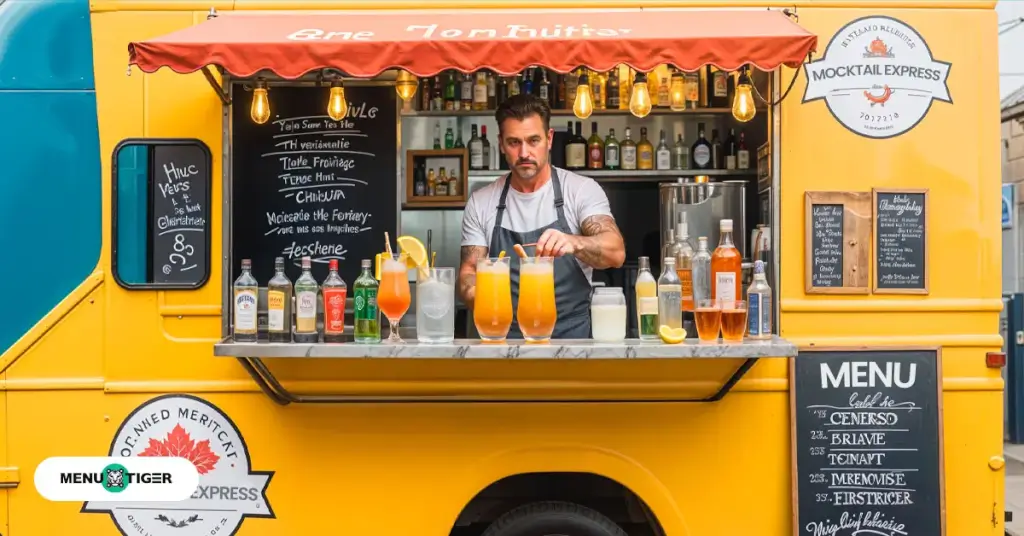Mobile bar business model is a versatile service that caters to various events and tests certain locations for future expansion plans.
If you’re interested in the latter, you’re in for a treat.
Bar expansion through mobile services translates to operating in new locations, reaching new customers, and adjusting to a more portable and minimal workflow than usual.
This poses a new challenge, from redoing your market research and business plan to re-strategizing marketing initiatives.
Plus, you’ll need to learn how to maximize the limited space while still offering top-grade service and beverages. One good way to do this is to upgrade printed menus with QR code menus to streamline the ordering process.
Or you can integrate a few more software and tools. Which ones and how you may ask. Read on further to know more.
Table of Contents
ToggleWhat does the industry report say about mobile bars?
The bar industry continuously keeps up with trending menu items, the latest tech tools to integrate, and even ways to amp up service.
The surge of mobile bars and food trucks, for instance, has caused this trend. And it’s understandable if you want to join in, too.
But it’s important to do your research. Look at what the market says and what the data reflects.
- Finmodelslab reported that as of 2022, the industry benchmarks suggest that the average annual income for mobile craft cocktail owners would range from $50,000 to $100,000.
This can still vary depending on several factors like location, menu, competition, and even seasonality.
- Owners might gain a normal profit margin that falls between 15 percent and 30 percent. This range accounts for the price of labor, ingredients, equipment, transportation, and marketing, in addition to other costs related to operating the business.
- Profitability-wise, MobileBevPros emphasized that bar and beverage service often accounts for 30 percent to 40 percent of a restaurant’s total profits.
Bars in mobile cart capitalize on this by operating in high-foot-traffic areas and large events, leading to increased profitability.
- Mobile bars can also serve a wide variety of events, including weddings, corporate meetings, festivals, parties, and more, which, on average, can charge between $500 and $2,000 per event, depending on the size, duration, and complexity of the service offered.
This means high-end events can command higher fees, increasing revenues.
How to open your mobile bar

Do your market research
Expanding your business requires extensive research, especially if you’re exploring a new business model. This groundwork is essential to building a solid and realistic mobile bar business plan that reflects both market demand and profitability.
This means that you need to ensure the feasibility and profitability of this project.
First, investigate the existence of bars on wheels in your area and how their customers respond to them.
If there’s none, you can conduct a survey about mobile bars.
Then, specify your target demographics: it could be catering services or event planners who want to have a bar during events.
Develop a business plan
Start developing a business plan with the data gathered from your market research.
Just like your physical bar, this business model needs a well-structured handbook to guide you.
Here, clarify the business concept you’re going for. Commonly, this type of bar service focuses on providing customizable beverage experiences for events.
It’s time to assemble your market research to build an insightful business plan for your business. After all, you need a roadmap to turn your business idea into a success.
Now, you could either stare at a blank screen for hours or get a kickstart on your plan with business plan software.
Either way, begin by clarifying the business concept you’re going for. Commonly, this type of bar service focuses on providing customizable beverage experiences for events.
Include the range of service packages, the diverse drink menu you’ll offer, and additional perks that come with it.
Of course, include a well-stated financial plan that has your projections and cash flow.
Ideally, the startup costs for this business are estimated at around $35,000. With projected annual revenue of $ 180,000 and monthly expenses of around $7,000, the break-even point will be in approximately six months.
However, this is subject to changes due to various factors like suppliers, locations, menus, and more.
Also, attach your operation, marketing, and growth strategies to complete your business plan.
Design your mobile cart

Designing your portable bar cart requires you to focus on balancing functionality, aesthetics, and practicality.
Here’s a detailed design concept:
- Structure and frame
Stainless steel or high-quality wood are good choices for structure for durability and a sleek look.
Nickel Institute pointed out that stainless steel is a vital ingredient for food safety because of its cleanability.
Its smooth, bright surfaces are easy to clean and can remain as is over time, withstanding wear and impact of constant temperature change.
While wood is renewable and recyclable, it offers a series of benefits, particularly for sustainability.
- Storage and shelving
When offering an on-the-go service like this, you need to put everything you need in a small truck or cart.
Cleverly maximizing spaces through storage and shelving is necessary. To do this, divide your shelves into four: top, middle, bottom, and side rack.
The top shelf is spacious enough for mixing drinks and storing frequently used items like shakers, glasses, and bottles.
The middle is usually adjustable or removable. It’s ideal for storing bottles, garnishes, and mixers. For organization, you can add dividers or a wine rack.
You can use the bottom shelf as an additional storage for large items like ice buckets, extra bottles, or bar tools.
Built-in racks on the side are for hanging your bar towels, cocktail napkins, or bar utensils.
- Aesthetics
Offer different finishes in your bar’s mobile cart that can greatly enhance its visual appeal, making it adaptable to various settings and personal tastes.
Natural wood is a good starter if you want to highlight a warm, rustic look that can complement both contemporary and traditional settings.
A polished stainless steel or aluminum finish is the best choice if you’re going for an industrial look. It offers a sleek, modern appearance that is both stylish and practical.
It is perfect for high-traffic areas like restaurants and event venues, providing a clean, professional look that is easy to maintain.
Create an appealing bar menu
Building mobile bar menu ideas can go from simple to complex, depending on the services you’ll offer.
For events, your clients usually decide what drinks will be served. You can offer various options, such as mocktails, cocktails, wine, spirits, or non-alcoholic beverages.
If you’re going to operate on the streets, it’s best to create a menu that requires little preparation yet delivers the quality your physical bar offers.
Hire staff
Hiring the right staff for your bar is crucial to providing customers with the utmost quality service.
The scope of their work might slightly differ from that of your usual house bartender. So, it’s important that you indicate in your traveling bartender job description all the qualities you need to manage your bar truck effectively.
Leverage job boards and online platforms to disseminate your job postings. This will help you reach your target candidates within your locations.
Selecting the right job board can make a big difference, as outlined in this study comparing the performance of job boards by Manatal.
Once you have your list of applicants, design simulation activities where they can showcase their skills in bartending.
Then, introduce your new hires to your bar’s operations, policies, and culture.
Plan your logistics and operations
A bar on a truck would require much more preparation than having it on site, particularly in logistics and operations.
Practice scheduling for a smoother workflow. Use an online calendar or software to keep track of all of your upcoming events and private bookings.
Create a rotating schedule for your staff to ensure coverage of all events. Consider factors like peak times, event sizes, and staff availability.
Also, explore using a restaurant order system or self-serving digital tool to assist your staff with the order-taking processes.
Keep in mind that you should maximize the use of GPS (Global Positioning System) and other route planning applications to assist you in determining the most efficient routes to event locations.
Note: Account for travel time when scheduling events to ensure punctuality, mainly if your service is hired. Factor in setup and teardown time as well.
Strategize for your mobile bar’s marketing
Like your onsite bar, this new business model requires thorough marketing initiatives to reach your target market.
Because it can be hired as a service for events and sell products in various locations, strategizing on promoting is crucial.
Social media is still a significant channel to market products and services, with a ballooned total number of users of 5.07 billion, 62.6 percent of the world’s population who uses the internet, reports from Statista as of April 2024.
Taking advantage of this number of users means upgrading your social network strategies based on trends.
Explore other ways in your social media that you haven’t tried yet, such as short-form video content, live streaming, user-generated content, influencer partnerships, stories, and highlights.
These can effectively contribute to connecting with your audience more interactively, turning their engagement into sales.

Additional tips to launch your trailer bar business successfully
Venturing in a new business type poses demands, particularly in getting it on the map. To navigate these, we’ve listed down tips and tricks for you:
Engage with the local community
Being part of the community makes it easier for your business to build partnerships and collaborations with other industries.
This lays the groundwork for strong networks, positioning your bar as a frontline for providing drink services to various events.
The first thing you need to do is to be actively engaged in your local activities.
Participate in holiday celebrations, free markets, and even charity events that will contribute to your visibility in the community.
Then, host events that connect with the locals; it could be free wine tasting or brewery workshops that encourage other businesses around the area to join as well.
Offer unique experiences
What makes a trail bar even more interesting — aside from drinks served through wheels — is the experience of having a sip in the streets, whether it’s in broad daylight or night time.
This customer experience can be upgraded into something valuable with your bar offering various technology integrations.
Virtual gift cards upon purchase are a great way to start it off. Customers can use them as they make another purchase of any item covered in the special deals or promos.
You can also make an offer for them to make their own drinks as part of the package.
Provide efficient and streamlined service

Having limited space to operate can make it challenging to provide a seamless service that is at par with your brick-and-mortar establishment.
That’s where technology like a QR code menu ordering system comes into the frame.
Here, you no longer have to worry about long wait lines cluttered and missed orders because your customers have the capacity to access your offerings simultaneously by just scanning the QR code.
More than that, this smart menu tool offers various solutions that expedite your order-taking processes, like e-payment alternatives.
This convenient way of ordering took a leap as 78 percent of respondents from the Eaters survey prefer menu QR codes over traditional paper menus, making it a relevant tool in the food and beverage industry.
Create professional branding for your mobile bar
Because of its nature of operation, your business’s chances of catching the public’s attention are quite high.
And taking advantage of it means you have to have a strong bar branding.
There are a few things you can do:
- Choose the right bar name
If you want to build a new image for your bar on wheels, go for the best bar names that resonate with your concept well.
This gives a sense of cohesiveness, especially if your physical store projects the same theme.
- Style and aesthetics
Be creative, especially in designing the exterior of your bar. Choose elements that are eye-catching and on-brand.
Use a color palette, logo, and other branding assets to create a cohesive look.
- Merchandise
Offering merchandise items in your bar station, such as shirts, hats, and drinkware, with your logo is an effective marketing strategy for your branding.
This promotes your brand and serves as additional revenue.
- Packaging
Ensure that your logo and colors are prominently displayed throughout your packaging. You can use sustainable materials for an eco-friendly approach to your bar.
Manage your finances wisely
Financial management can make any of your business ventures from zero to hero.
As simple as creating and regularly adjusting a comprehensive budget, meticulously tracking income and expenses, and ensuring adequate cash flow to cover daily operations and unexpected costs will guarantee you positive returns.
Also, start planning on strategic pricing in order for you to control costs and maximize your revenue.
With these strategies being applied correctly, it will significantly help you reduce costs, increase your profitability, and lock in your bar’s long term success.

Raising the bar: Equipping drink service on truck with interactive restaurant QR code menu software

In any food truck business, the number one concern most operators have is providing customer service, where convenience and comfort are felt.
In fact, a National Restaurant Association report says that approximately 70 percent of customers expect their food within 10 minutes of placing an order, making speed of service one of the top expectations for customers when visiting any food trucks.
This is deeply rooted in the business’s operational structure — it is far from the sit-and-eat approach of a physical establishment.
More so, the limited spaces you have to make your daily operations go smoothly.
But, there’s a need not to worry as digital technology like MENU TIGER digital menu QR code software is designed to assist in achieving streamlined overall services.
Here’s how:
Customizable digital menu
Changes in your bar truck menu can happen regularly, especially if you’re targeting to operate in various seasons.
It would be a hassle and costly at the same time to reprint menus whenever you make menu updates.
That’s why MENU TIGER has this customizable digital menu, which you can make changes to anytime, anywhere, without additional cost.
Ease of ordering with a QR code menu
Speaking of your digital menu, your customers can access this by scanning a QR code, reducing wait times when ordering.
This mobile ordering system allows them to conveniently place their orders simultaneously through their smartphones and pay instantly—without the need to line up or flag down staff.
Note: Since you’ll be serving diverse demographics, expect that there are some who are not familiar with using this tool yet. To accommodate them, have printed easy-to-follow instructions on how to scan a menu QR code or provide assistance, especially for the elderly and people with disabilities.
Cloud-based POS integration
Simplifying your inventory is a great help inside your truck.
MENU TIGER’s Loyverse integration offers various solutions, like sales tracking and inventory management with just using your smartphone or tablet.
No need to install heavy-duty hardwares that can take up space in your counter and pile of files for your stocks.
Get your wheels ready to hit the road with your mouth-watering drinks
Coupling your conventional business with a mobile bar service is a strategic move as an addition to your revenue stream.
Not only does it bring your favorite drinks to people, but it also provides an opportunity to showcase your bar’s culture to them.
Ofcourse, expansion requires a lot of planning, particularly in giving the same level of quality service your on-site bar offers.
Investing in advanced tools like MENU TIGER QR code menu software can equip your business to streamline processes from ordering to serving items, regardless of the limitations you have.
What’s even interesting about this is it offers more. So, get your chance to explore by visiting the website and signing up.
A whole new level of service awaits you.
FAQs
A portable bar is a compact, mobile unit designed to facilitate the serving of beverages in various settings.
This is typically equipped with essential features such as countertops, shelves or compartments for storing bottles, glassware, and other bar tools, and sometimes even built-in coolers or sinks.
The purpose of having a service bar is to enhance the efficiency and organization of drink preparations and services within a restaurant, bar, or event venue.
It functions as a dedicated area where bartenders or bar staff prepare beverages exclusively for delivery by waitstaff rather than serving customers directly.



